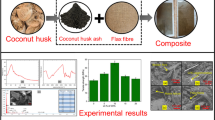Abstract
Corn stalk biochar (CSB), which was prepared from corn stalk (CS), was used to strengthen high-density polyethylene (HDPE). CSB/HDPE composite (CSBH) was prepared by extrusion. In this paper, we studied the effect of CSB on flame retardancy and aging resistance of HDPE. CSB and CSBH were characterized via scanning electron microscopy (SEM), thermogravimetric analysis (TGA), Fourier transform infrared spectroscopy (FTIR), X-ray photoelectron spectroscopy (XPS), limit oxygen index tester (LOI), and miniature combustion calorimeter (MCC). The results showed that, compared with CS, the aromatization degree of CSB increased. Compared with HDPE, the anti-aging properties of CSBH were significantly improved. SEM results showed that the surface of CSBH was still smooth after 28 days of aging treatment, and the carbonyl index (CI) did not change much. With the addition of CSB, the flame-retardant properties of HDPE material were enhanced. The TGA diagram confirmed that CSB improved the stability of HDPE material. In summary, biochar is able to enhance thermal stability, flame-retardant, and anti-aging properties of biocomposites.










Similar content being viewed by others
Data Availability
The data that support the findings of this study are available from the corresponding author upon reasonable request.
References
K. Beydoun, J. Klankermayer, Efficient plastic waste recycling to value-added products by integrated biomass processing[J]. Chemsuschem 13(3), 488–492 (2020)
M.J. Ahmed, B.H. Hameed, Insight into the co-pyrolysis of different blended feedstocks to biochar for the adsorption of organic and inorganic pollutants: a review[J]. J. Clean. Prod. 265, 121762 (2020)
Q.F. Zhang, W.M. Yi, Z.H. Li, L.H. Wang, H.Z. Cai, Mechanical properties of rice husk biochar reinforced high density polyethylene composites[J]. Polymers 10(3), 286 (2018)
A. Khan, P. Savi, S. Quaranta, M. Rovere, M. Giorcelli, A. Tagliaferro, C. Rosso, C. Jia, Low-cost carbon fillers to improve mechanical properties and conductivity of epoxy composites[J]. Polymers 9, 642 (2017)
D.B. Devallance, G.S. Oporto, P. Quigley, Investigation of hardwood biochar as a replacement for wood flour in wood-polypropylene composites[J]. J. Elastomers. Plast 48(6), 510–522 (2016)
N. Nan, D.B. Devallance, X. Xie, J. Wang, The effect of bio-carbon addition on the electrical, mechanical, and thermal properties of polyvinyl alcohol/biochar composites[J]. J. Compos. Mater. 50(9), 1161–1168 (2016)
Q.F. Zhang, D.H. Zhang, H. Xu, W.Y. Lu, X.J. Ren, H.Z. Cai, H.W. Lei, E.G. Huo, F. Zhao, Q. Moriko, X.N. Lin, M.V. Elmar, M. Wendy, Biochar filled high-density polyethylene composites with excellent properties: towards maximizing the utilization of agricultural wastes[J]. Ind Crops Prod 146, 112185 (2020)
Y.F. Shih, L.T. Wan, V.K. Kotharangannagari, Development of eco-friendly flame-retarded high density polyethylene composites[J]. Key Eng. Mater 847, 55–60 (2020)
Z. Jia, J. Huang, Y. Gong, P. Jin, X. Suo, H. Li, Incorporation of copper enhances the anti-ageing property of flame-sprayed high-density polyethylene coatings[J]. J. Therm. Spray. Techn. 26(3), 409–416 (2017)
M. Michalak, M. Hakkarainen, A.C. Albertsson, Recycling oxidized model polyethylene powder as a degradation enhancing filler for polyethylene/polycaprolactone blends[J]. ACS Sustain. Chem. Eng 4, 129–135 (2016)
D.S. Bajwa, S.G. Bajwa, G.A. Holt, Impact of biofibers and coupling agents on the weathering characteristics of composites[J]. Polym. Degrad. Stab 120, 212–219 (2015)
X. Lin, L. Kong, H. Cai, Q. Zhang, D. Bi, W. Yi, Effects of alkali and alkaline earth metals on the co-pyrolysis of cellulose and high density polyethylene using TGA and Py-GC/MS[J]. Fuel Process. Technol 191, 71–78 (2019)
D.G. Bhowmick, A.K. Sarmah, R. Sen, Production and characterization of a value added biochar mix using seaweed, rice husk and pine sawdust: a parametric study[J]. J. Clean. Prod. 200, 641–656 (2018)
D. Jiang, M. Pan, X. Cai, Y. Zhao, Flame retardancy of rice straw polyethylene composites affected by in situ polymerization of ammonium polyphosphate/silica[J]. Compos. Part A Appl. Sci. Manuf 109, 1–9 (2018)
O. Das, D. Bhattacharyya, D. Hui, K.T. Lau, Mechanical and flammability characterisations of biochar/polypropylene biocomposites[J]. Compos. Part B Eng 106, 120–128 (2016)
C. Chen, X. Yan, Y. Xu, B.A. Yoza, X. Wang, Y. Kou, H. Ye, Q. Wang, Q. Li, Activated petroleum waste sludge biochar for efficient catalytic ozonation of refinery wastewater[J]. Sci. Total Environ 651, 2631–2640 (2019)
D. Wei, B. Li, H. Huang, L. Luo, J. Zhang, Y. Yang, J. Guo, L. Tang, G. Zeng, Y. Zhou, Biochar-based functional materials in the purification of agricultural wastewater: fabrication, application and future research needs[J]. Chemosphere 197, 165–180 (2018)
K. Dai, S. Sun, W. Xu, B. Song, Y.Z. Deng, X.D. Qian, Covalently-functionalized graphene oxide via introduction of bifunctional phosphorus-containing molecules as an effective flame retardant for polystyrene[J]. RSC Adv 8(44), 24993–25000 (2018)
Y.Z. Wang, X.Y. Liu, Z. Shi, Y.X. Lin, Y.H. Yang, S.B. Dong, T.Y. Lan, Rheological behavior of high density polyethylene (HDPE) filled with corn stalk biochar[J]. ChemistrySelect (2021). https://doi.org/10.1002/SLCT.202102663
N.M. Stark, L.M. Matuana, Surface chemistry changes of weathered HDPE/wood flow composites studied by XPS and FTIR spectroscopy[J]. Polym Degrad Stabil 86, 19 (2004)
Acknowledgements
This work was supported by open project of Polymer matrix Composites Key Laboratory of Heilongjiang Province (No: 130712121025).
Author information
Authors and Affiliations
Corresponding authors
Ethics declarations
Conflict of Interest
Authors have no conflict of interest to declare.
Rights and permissions
Springer Nature or its licensor (e.g. a society or other partner) holds exclusive rights to this article under a publishing agreement with the author(s) or other rightsholder(s); author self-archiving of the accepted manuscript version of this article is solely governed by the terms of such publishing agreement and applicable law.
About this article
Cite this article
Wang, Y., Liu, X., Lan, T. et al. Corn Stalk Biochar-Reinforced High-Density Polyethylene Material: Flame-Retardant and Anti-aging Properties. Fibers Polym 24, 1771–1779 (2023). https://doi.org/10.1007/s12221-023-00044-8
Received:
Revised:
Accepted:
Published:
Issue Date:
DOI: https://doi.org/10.1007/s12221-023-00044-8




